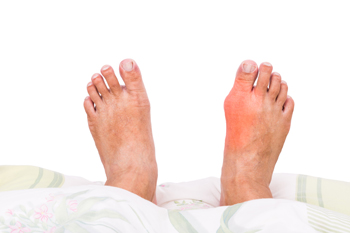 Bunions are bony bumps that form on the outside of the big toe at the base of the joint. Bunions typically form due to excess pressure being placed on the big toe joint over time. However, there are several other types of bunions as well. A congenital hallux valgus refers to a bunion that is present in a baby at birth. Juvenile or adolescent hallux valgus refer to bunions that occur in children between the ages of 10 and 15. A Tailor’s bunion, which is also known as a bunionette, forms on the outside of the pinky toe, rather than on the big toe. Bunions may not cause symptoms initially, but tend to progress and become more uncomfortable and even painful over time. If you have bunions, it is suggested that you see a podiatrist for treatment.
Bunions are bony bumps that form on the outside of the big toe at the base of the joint. Bunions typically form due to excess pressure being placed on the big toe joint over time. However, there are several other types of bunions as well. A congenital hallux valgus refers to a bunion that is present in a baby at birth. Juvenile or adolescent hallux valgus refer to bunions that occur in children between the ages of 10 and 15. A Tailor’s bunion, which is also known as a bunionette, forms on the outside of the pinky toe, rather than on the big toe. Bunions may not cause symptoms initially, but tend to progress and become more uncomfortable and even painful over time. If you have bunions, it is suggested that you see a podiatrist for treatment.
If you are suffering from bunions, contact one of our podiatrists of Family Foot Care of Long Island. Our doctors can provide the care you need to keep you pain-free and on your feet.
What Is a Bunion?
A bunion is formed of swollen tissue or an enlargement of boney growth, usually located at the base joint of the toe that connects to the foot. The swelling occurs due to the bones in the big toe shifting inward, which impacts the other toes of the foot. This causes the area around the base of the big toe to become inflamed and painful.
Why Do Bunions Form?
Genetics – Susceptibility to bunions are often hereditary
Stress on the feet – Poorly fitted and uncomfortable footwear that places stress on feet, such as heels, can worsen existing bunions
How Are Bunions Diagnosed?
Doctors often perform two tests – blood tests and x-rays – when trying to diagnose bunions, especially in the early stages of development. Blood tests help determine if the foot pain is being caused by something else, such as arthritis, while x-rays provide a clear picture of your bone structure to your doctor.
How Are Bunions Treated?
- Refrain from wearing heels or similar shoes that cause discomfort
- Select wider shoes that can provide more comfort and reduce pain
- Anti-inflammatory and pain management drugs
- Orthotics or foot inserts
- Surgery
If you have any questions, please feel free to contact our office located in Port Jefferson Station, NY . We offer the newest diagnostic and treatment technologies for all your foot care needs.
